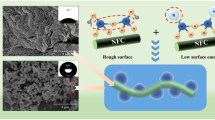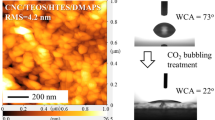Abstract
A new strategy for the surface modification of bacterial cellulose (BC) through the combination of oxygen plasma deposition and silanization with trichloromethyl silane (TCMS) is described. The combined use of the two techniques modifies both the surface roughness and energy and therefore maximizes the obtained hydrophobic effect. These modified membranes were characterized by Scanning Electron Microscopy (SEM), water contact angle measurements, Fourier-transform infrared spectroscopy (FTIR-ATR) and X-ray photoelectron spectroscopy (XPS), and its cytotoxic potential was investigated using both indirect and direct contact in vitro studies. The obtained results suggest an effective conjugation of TCMS to the surface of BC, leading to a highly hydrophobic surface, with a water contact angle of approximately 130º. It is also demonstrated that this is a stable and durable surface modification strategy, since BC remained hydrophobic even after 6 months, in dry conditions or after being submerged in distilled water for about a month. Importantly, this surface modification revealed no short-term cytotoxic effects on L929 and hDNFs cells. Altogether, these data indicate the successful development of a surface modification method that can be applied to BC, enabling the production of a biodegradable and hydrophobic platform that can be applied to different areas of research and industry.
Graphic abstract









Similar content being viewed by others
References
Bhushan B, Jung YC (2011) Effects of surface structure on wetting of patterned superhydrophobic surfaces. In: Drummond CH& III (Eds.), 68th Conference on glass problems, vol. 29. Wiley
Bhushan B, Nosonovsky M (2010) The rose petal effect and the modes of superhydrophobicity. Philos Trans A Math Phys Eng Sci 368(1929):4713–4728. https://doi.org/10.1098/rsta.2010.0203
Cacicedo ML, Castro MC, Servetas I, Bosnea L, Boura K, Tsafrakidou P, Castro GR et al (2016) Progress in bacterial cellulose matrices for biotechnological applications. Bioresour Technol 213:172–180. https://doi.org/10.1016/j.biortech.2016.02.071
Calvimontes A, Mauersberger P, Nitschke M, Dutschk V, Simon F (2011) Effects of oxygen plasma on cellulose surface. Cellulose 18(3):802–809. https://doi.org/10.1007/s10570-011-9511-5
Cassie ABD, Baxter S (1944) Wettability of porous surfaces. Trans Faraday Soc 40:546–551. https://doi.org/10.1039/TF9444000546
Costa MN, Veigas B, Jacob JM, Santos DS, Gomes J, Baptista PV, Fortunato E et al (2014) A low cost, safe, disposable, rapid and self-sustainable paper-based platform for diagnostic testing: lab-on-paper. Nanotechnology 25(9):094006. https://doi.org/10.1088/0957-4484/25/9/094006
Costa AFS, Almeida FCG, Vinhas GM, Sarubbo LA (2017) Production of bacterial cellulose by gluconacetobacter hansenii using corn steep liquor as nutrient sources. Front Microbiol 8:2027. https://doi.org/10.3389/fmicb.2017.02027
Creighton JR, Ho P (2010) Introduction to Chemical Vapour Deposition| SpringerLink. In: Xu Y, Yan X-T (eds) engineeing materials and processes. Springer, London, pp 1–28
Fadeev AY, McCarthy TJ (2000) Self-Assembly Is Not the Only Reaction Possible between Alkyltrichlorosilanes and Surfaces: monomolecular and Oligomeric Covalently Attached Layers of Dichloro—and Trichloroalkylsilanes on Silicon. Langmuir 16(18):7268–7274. https://doi.org/10.1021/la000471z
Faria G, Cardoso CR, Larson RE, Silva JS, Rossi MA (2009) Chlorhexidine-induced apoptosis or necrosis in L929 fibroblasts: a role for endoplasmic reticulum stress. Toxicol Appl Pharmacol 234(2):256–265. https://doi.org/10.1016/j.taap.2008.10.012
Fink H, Faxalv L, Molnar GF, Drotz K, Risberg B, Lindahl TL, Sellborn A (2010) Real-time measurements of coagulation on bacterial cellulose and conventional vascular graft materials. Acta Biomater 6(3):1125–1130. https://doi.org/10.1016/j.actbio.2009.09.019
Glavan AC, Martinez RV, Subramaniam AB, Yoon HJ, Nunes RMD, Lange H, Whitesides GM et al (2013) Omniphobic “RF Paper” Produced by Silanization of Paper with Fluoroalkyltrichlorosilanes. Adv Func Mater 24:60–70
Helenius G, Backdahl H, Bodin A, Nannmark U, Gatenholm P, Risberg B (2006) In vivo biocompatibility of bacterial cellulose. J Biomed Mater Res A 76(2):431–438. https://doi.org/10.1002/jbm.a.30570
Hong X, Gao X, Jiang L (2007) Application of Superhydrophobic Surface with High Adhesive Force in No Lost Transport of Superparamagnetic Microdroplet. J Am Chem Soc 129(6):1478–1479. https://doi.org/10.1021/ja065537c
Huang Y, Zhu C, Yang J, Nie Y, Chen C, Sun D (2014) Recent advances in bacterial cellulose. Cellulose 21(1):1–30
ISO 10993-5. (2009). Biological evaluation of medical devices. In: Part 5: Tests for in vitro cytotoxicity, 3rd ed. pp 34)
Jedrzejczak-Krzepkowska M, Kubiak K, Ludwicka K, Bielecki S (2016) Chapter 2—bacterial nanocellulose synthesis, recent findings. In: Gama M, Dourado F, Bielecki S (eds) Bacterial nanocel-lulose: from biotechnology to bio-economy. Elsevier, New York, pp 19–46
Katara G, Hemvani N, Chitnis S, Chitnis V, Chitnis DS (2008) Surface disinfection by exposure to germicidal UV light. Indian J Med Microbiol 26(3):241–242
Klemm D, Heublein B, Fink HP, Bohn A (2005) Cellulose: fascinating biopolymer and sustainable raw material. Angew Chem Int Ed Engl 44(22):3358–3393. https://doi.org/10.1002/anie.200460587
Kumar A, Negi YS, Choudhary V, Bhardwaj NK (2014) Characterization of cellulose nanocrystals produced by acid-hydrolysis from sugarcane bagasse as agro-waste. J Mater Phys Chem 2(1):1–8
Leitao AF, Faria MA, Faustino AM, Moreira R, Mela P, Loureiro L, Gama M et al (2016) A novel small-caliber bacterial cellulose vascular prosthesis: production, characterization, and preliminary in vivo testing. Macromol Biosci 16(1):139–150. https://doi.org/10.1002/mabi.201500251
Mohd NH, Ismail NFH, Zahari JI, Wan Fathilah WFb, Kargarzadeh H, Ramli S, Othaman R et al (2016) Effect of aminosilane modification on nanocrystalline cellulose properties. J Nanomater 2016 2016:8. https://doi.org/10.1155/2016/4804271
Mosmann T (1983) Rapid colorimetric assay for cellular growth and survival: application to proliferation and cytotoxicity assays. J Immunol Methods 65(1–2):55–63. https://doi.org/10.1016/0022-1759(83)90303-4
North EJ, Halden RU (2013) Plastics and environmental health: the road ahead. Rev Environ Health 28(1):1–8
Pan C, Kumar C, Bohl S, Klingmueller U, Mann M (2009) Comparative proteomic phenotyping of cell lines and primary cells to assess preservation of cell type-specific functions. Mol Cell Proteomics 8(3):443–450. https://doi.org/10.1074/mcp.M800258-MCP200
Petersen N, Gatenholm P (2011) Bacterial cellulose-based materials and medical devices: current state and perspectives. Appl Microbiol Biotechnol 91(5):1277–1286. https://doi.org/10.1007/s00253-011-3432-y
Picheth GF, Pirich CL, Sierakowski MR, Woehl MA, Sakakibara CN, de Souza CF, de Freitas RA et al (2017) Bacterial cellulose in biomedical applications: a review. Int J Biol Macromol 104:97–106. https://doi.org/10.1016/j.ijbiomac.2017.05.171
Rachini A, Le Troedec M, Peyratout C, Smith A (2012) Chemical modification of hemp fibers by silane coupling agents. J Appl Polym Sci 123(1):601–610. https://doi.org/10.1002/app.34530
Riss TL, Moravec RA, Niles AL, Duellman S, Benink HA, Worzella TJ, Minor L (2016) Cell viability assays. In: Assay guidance manual: Eli Lilly & Company and the National Center for Advancing Translational Sciences
Seo K, Kim M, Kim DH (2015) Re-derivation of Young’s equation, Wenzel equation, and Cassie-Baxter equation based on energy minimization. In: Aliofkhazraei M (ed) Surface energy. IntechOpen, London
Shao W, Wu J, Liu H, Ye S, Jiang L, Liu X (2017) Novel bioactive surface functionalization of bacterial cellulose membrane. Carbohyd Polym 178:270–276
Silva MA, Leite YKC, de Carvalho CES, Feitosa MLT, Alves MMM, Carvalho FAA, de Carvalho MAM et al (2018) Behavior and biocompatibility of rabbit bone marrow mesenchymal stem cells with bacterial cellulose membrane. PeerJ 6:e4656. https://doi.org/10.7717/peerj.4656
Song J, Rojas OJ (2013) Approaching super-hydrophobicity from cellulosic materials: a review. Nord Pulp Pap Res J 28(2):216–238
Svensson A, Nicklasson E, Harrah T, Panilaitis B, Kaplan DL, Brittberg M, Gatenholm P (2005) Bacterial cellulose as a potential scaffold for tissue engineering of cartilage. Biomaterials 26(4):419–431. https://doi.org/10.1016/j.biomaterials.2004.02.049
Thuo MM, Martinez RV, Lan W-J, Liu X, Barber J, Atkinson MBJ, Whitesides GM et al (2014) Fabrication of low-cost paper-based microfluidic devices by embossing or cut-and-stack methods. Chem Mater 26(14):4230–4237
Wang Y-W, Wu Q, Chen G-Q (2003) Reduced mouse fibroblast cell growth by increased hydrophilicity of microbial polyhydroxyalkanoates via hyaluronan coating. Biomaterials 24(25):4621–4629. https://doi.org/10.1016/S0142-9612(03)00356-9
Wenzel RN (1936) Resistance of solid surfaces to wetting by water. Ind Eng Chem 28(8):988–994. https://doi.org/10.1021/ie50320a024
Zhang H, Li Y, Xu Y, Lu Z, Chen L, Huang L, Fan M (2016) Versatile fabrication of a superhydrophobic and ultralight cellulose-based aerogel for oil spillage clean-up. Phys Chem Chem Phys 18(40):28297–28306. https://doi.org/10.1039/C6CP04932J
Zimmermann KA, LeBlanc JM, Sheets KT, Fox RW, Gatenholm P (2011) Biomimetic design of a bacterial cellulose/hydroxyapatite nanocomposite for bone healing applications. Mater Sci Eng C 31(1):43–49. https://doi.org/10.1016/j.msec.2009.10.007
Acknowledgments
This work was supported by the Fundação para a Ciência e a Tecnologia (FCT), under the project “SkinChip: Disruptive cellulose-based microfluidic device for 3D skin modelling” (PTDC/BBB-BIO/1889/2014, SFRH/BPD/121526/2016), co-financed by the Lisboa 2020, COMPETE 2020, Portugal 2020 and the BioTecNorte operation (NORTE‐01‐0145‐FEDER‐000004) with funding by the European Regional Development Fund under the scope of Norte2020—Programa Operacional Regional do Norte.
Author information
Authors and Affiliations
Corresponding author
Ethics declarations
Conflict of interest
No potential conflict of interest was reported by the authors
Additional information
Publisher's Note
Springer Nature remains neutral with regard to jurisdictional claims in published maps and institutional affiliations.
Rights and permissions
About this article
Cite this article
Leal, S., Cristelo, C., Silvestre, S. et al. Hydrophobic modification of bacterial cellulose using oxygen plasma treatment and chemical vapor deposition. Cellulose 27, 10733–10746 (2020). https://doi.org/10.1007/s10570-020-03005-z
Received:
Accepted:
Published:
Issue Date:
DOI: https://doi.org/10.1007/s10570-020-03005-z




